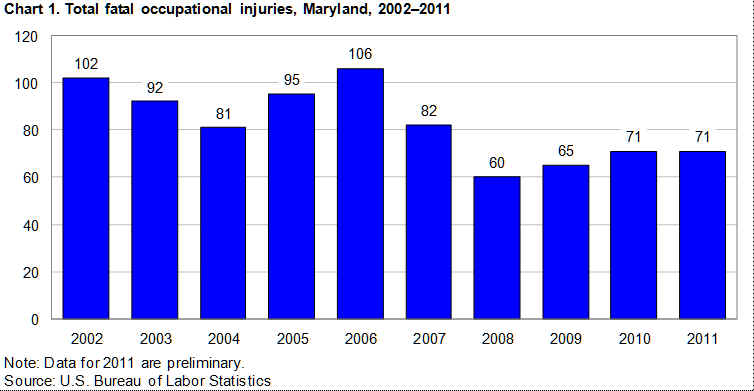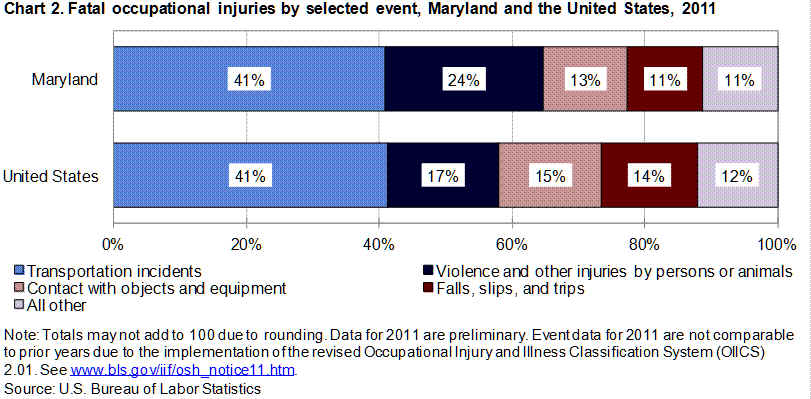Download this document (Word document,
52KB, download Word viewer for free)
(PDF document, 87KB,
download Adobe Acrobat for free)
The Maryland Department of Labor, Licensing and Regulation, Division of Labor and Industry in cooperation with
the U.S. Department of Labor, Bureau of Labor Statistics conducts the Census of Fatal Occupational Injuries (CFOI)
program. CFOI provides a complete count of all fatal work injuries occurring in Maryland and in the United States in
each calendar year.
Preliminary results for Maryland, 2011
In 2011, fatal work injuries in Maryland totaled 71 according to the preliminary results from the Maryland Census
of Fatal Occupational Injuries (CFOI) program. The majority of these cases are not under MOSH jurisdiction. This count
remains unchanged from 2010's final count for the State. Final fatality numbers for Maryland and the nation will be
released in April 2013.
|
Highlights from the Maryland Census of Fatal Occupational Injuries, 2011
- The construction industry sector had the largest number of fatalities in the State with 13, down from 18 in the
previous year. The specialty trade contractor industry (NAICS 238) accounted for 11 of the worker deaths in 2011.
- Transportation and warehousing (NAICS 48-49) had the second-highest fatality count with 11, compared to 9 in
2010. Transportation incidents accounted for eight worker deaths in this sector in 2011.
- The administrative and support and waste management and remediation services sector (NAICS 56) followed with
10 work-related fatalities, up from 7 in the prior year. Half of these incidents in 2011 occurred in landscaping services.
- Transportation and material moving occupations had the highest number of workplace fatalities in Maryland with
20. The majority of these fatalities (12) were heavy and tractor-trailer truck drivers. Workers in construction and
extraction occupations had the next-highest fatality count at 11.
- Men accounted for 65, or 92 percent, of the work-related fatalities in the state, the same percentage as the
nation. Transportation incidents made up 40 percent of fatalities among men in Maryland.
- In Maryland, 46 percent of those who died from a workplace injury were white, non-Hispanic. This was lower than
the 71 percent reported for this racial group nationwide. Thirty-eight percent of fatally injured in Maryland were
black or African-American, non-Hispanic. African-Americans accounted for 9 percent of work-related deaths in the nation.
The number of Hispanic or Latino fatalities declined in Maryland from the previous year's count of 12 down to 8 in 2011.
In addition, Hispanic or Latino workers accounted for 11 percent of the State-wide total.
- Of the 71 fatality cases in Maryland, 79 percent of the decedents worked for wages and salaries; the remainder were
self-employed. The most frequent fatal event for a wage and salary worker was a transportation incident, while for
the self-employed it was violence and other injuries by persons or animals.
- The month recording the most fatalities was June with 10 reported cases. The fewest deaths were recorded in October with 3.
Technical Notes
The CFOI program uses diverse State and federal data sources to identify, verify and profile fatal work injuries.
Information about each workplace fatality (e.g., industry, occupation, and other worker characteristics, such as, the
equipment used and circumstances of the event) is obtained by cross-referencing multiple source documents, such as death
certificates, workers' compensation reports, news media accounts, and reports to State and federal agencies. Diverse
sources are used because studies have shown that no single source captures all job-related fatalities. The documents
are matched so that each fatality is counted only once. These methods assure counts are as complete and accurate as possible.
For a fatality to be included in the census, the decedent must have been employed (that is, working for pay,
compensation, or profit) at the time of the event, engaged in a legal work activity, or present at the site of the
incident as a requirement of his or her job. Fatalities to volunteers and unpaid family workers who perform the
same duties and functions as paid workers are also included in the count. These criteria are generally broader than
those used by State and federal agencies administering specific laws and regulations. (Fatalities that occur during
a person's normal commute to or from work are excluded from the census counts.)
Data presented in this release include deaths occurring in 2011 that resulted from traumatic occupational injuries.
An injury is defined as any wound or damage to the body resulting from acute exposure to energy, such as heat,
electricity, or impact from a crash or fall, or from the absence of such essentials as heat or oxygen, caused by
a specific event or incident within a single workday or shift. Included are open wounds, intracranial and internal
injuries, heatstroke, hypothermia, asphyxiation, acute poisonings resulting from short-term exposures limited to the
worker's shift, suicides and homicides, and work injuries listed as underlying or contributory causes of death.
The CFOI program presents data for all fatal work injuries, regardless of whether the decedent was working in a
job covered under the regulatory oversight of the Maryland Occupational Safety and Health Agency or other State and
Federal agencies. Thus, any comparison between the Maryland CFOI counts and those released by other agencies should
take into account the different coverage requirements and definitions being used by each agency.
Information on work-related fatal illnesses is not reported in the Maryland Census of Fatal Occupational Injuries
because the latency period associated with many types of occupational illness, and the difficulty of linking those
illnesses to work exposures, make identification of a universe problematic.
|
For additional information, contact:
MOSH Research and Statistics Unit
10946 Golden West Drive
Suite 160
Hunt Valley, MD 21031
Phone: 410-527-4465
Fax: 410-527-4497
|
|


